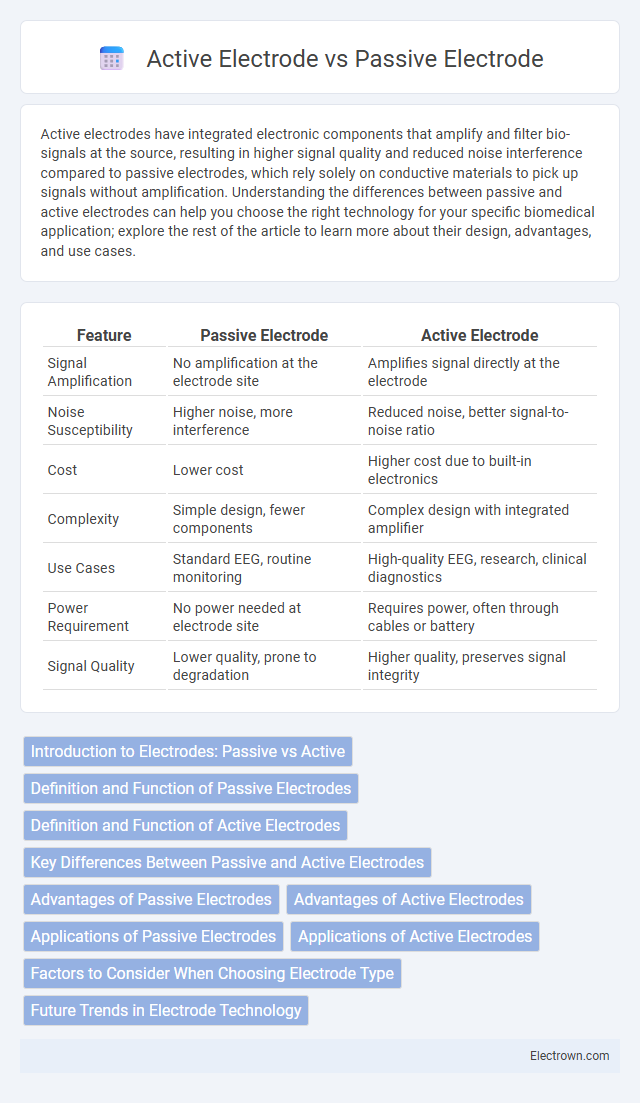Active electrodes have integrated electronic components that amplify and filter bio-signals at the source, resulting in higher signal quality and reduced noise interference compared to passive electrodes, which rely solely on conductive materials to pick up signals without amplification. Understanding the differences between passive and active electrodes can help you choose the right technology for your specific biomedical application; explore the rest of the article to learn more about their design, advantages, and use cases.
Table of Comparison
| Feature | Passive Electrode | Active Electrode |
|---|---|---|
| Signal Amplification | No amplification at the electrode site | Amplifies signal directly at the electrode |
| Noise Susceptibility | Higher noise, more interference | Reduced noise, better signal-to-noise ratio |
| Cost | Lower cost | Higher cost due to built-in electronics |
| Complexity | Simple design, fewer components | Complex design with integrated amplifier |
| Use Cases | Standard EEG, routine monitoring | High-quality EEG, research, clinical diagnostics |
| Power Requirement | No power needed at electrode site | Requires power, often through cables or battery |
| Signal Quality | Lower quality, prone to degradation | Higher quality, preserves signal integrity |
Introduction to Electrodes: Passive vs Active
Electrodes serve as critical components in bioelectrical measurements, with passive and active types differing in signal acquisition methods and noise reduction capabilities. Passive electrodes rely on external amplifiers and are more susceptible to environmental interference, making them suitable for controlled settings but less effective in dynamic environments. Active electrodes integrate preamplification at the electrode site, enhancing signal quality by minimizing noise and impedance, thereby improving measurement accuracy in applications like EEG and EMG.
Definition and Function of Passive Electrodes
Passive electrodes, characterized by their inert conductive surfaces such as silver/silver chloride or platinum, function primarily as sensors that detect electrical signals without injecting current into the tissue. Their main role in biomedical applications, including EEG and ECG, is to pick up bioelectric potentials generated by cellular activity, ensuring minimal interference with the signal source. Unlike active electrodes, passive electrodes rely entirely on external amplification to process the detected signals for accurate physiological monitoring.
Definition and Function of Active Electrodes
Active electrodes are sensors that directly detect or deliver electrical signals to biological tissues, playing a critical role in measuring bioelectric activity or stimulating nerves and muscles. These electrodes incorporate built-in amplification or signal conditioning components, enhancing signal quality and reducing noise for more precise readings. Unlike passive electrodes, which serve as simple conductors without signal processing, active electrodes improve the accuracy and reliability of electrophysiological measurements in medical and research applications.
Key Differences Between Passive and Active Electrodes
Passive electrodes rely on direct skin contact without built-in amplification, making them sensitive to noise and requiring external amplifiers. Active electrodes contain integrated amplifiers that boost signals at the source, reducing interference and improving signal quality. This fundamental distinction impacts signal clarity, ease of use, and overall performance in biosignal acquisition systems.
Advantages of Passive Electrodes
Passive electrodes offer several advantages, including lower cost and simpler design compared to active electrodes, making them suitable for large-scale and budget-sensitive applications. Their minimal electronics reduce maintenance requirements and enhance durability in various environments. You benefit from straightforward integration and reliable performance, especially in settings where high amplification near the measurement site is unnecessary.
Advantages of Active Electrodes
Active electrodes offer enhanced signal quality by amplifying bioelectrical signals directly at the source, reducing susceptibility to noise and interference. This leads to improved accuracy and reliability in electrophysiological measurements such as EEG, EMG, and ECG. Their design allows for better patient comfort and shorter setup times compared to passive electrodes.
Applications of Passive Electrodes
Passive electrodes are widely used in medical diagnostics, especially in electroencephalography (EEG) and electromyography (EMG) to detect electrical activity from the brain and muscles. They are favored in applications requiring stable, low-noise signal acquisition over extended periods, such as monitoring neural activity during sleep studies or epilepsy diagnosis. Understanding how passive electrodes interact with the skin can help you optimize electrode placement and signal quality for accurate physiological measurements.
Applications of Active Electrodes
Active electrodes are widely used in biomedical applications such as electroencephalography (EEG) and electromyography (EMG) to improve signal quality by amplifying biopotential signals at the source. Their integrated amplification reduces noise and interference, making them ideal for wearable health-monitoring devices and long-term patient observation. The enhanced sensitivity of active electrodes supports accurate diagnostics and real-time monitoring in clinical and research settings.
Factors to Consider When Choosing Electrode Type
Factors to consider when choosing between passive and active electrodes include signal quality, noise sensitivity, and application requirements. Active electrodes contain built-in amplifiers that enhance signal-to-noise ratio, making them ideal for environments with high electrical interference, while passive electrodes rely on external amplification and may be more susceptible to noise. Your specific needs, such as portability, setup complexity, and measurement precision, will determine which electrode type best suits your application.
Future Trends in Electrode Technology
Future trends in electrode technology emphasize the development of active electrodes with enhanced sensitivity and signal-to-noise ratio, driven by advancements in nanomaterials and flexible electronics. Passive electrodes continue to evolve with improved biocompatibility and ease of application, catering to wearable and long-term monitoring devices. Your choice of electrode type may soon benefit from hybrid solutions that combine the stability of passive electrodes with the responsiveness of active systems.
Passive vs Active Electrode Infographic

 electrown.com
electrown.com